Business Strategy Analysis Report: L'Oréal, Semester 2, [University]
VerifiedAdded on 2020/11/23
|13
|4120
|86
Report
AI Summary
This report provides a comprehensive business strategy analysis of L'Oréal S.A., a leading French personal care company. The analysis begins with an introduction to business strategy and its importance, followed by an examination of L'Oréal's macro-environment using PESTEL analysis, covering political, economic, social, technological, environmental, and legal factors. The report then delves into an internal assessment using SWOT analysis to identify the company's strengths, weaknesses, opportunities, and threats. A competitive analysis is conducted using Porter's Five Forces model to evaluate the competitive landscape. Finally, the report explores different strategic directions available to L'Oréal, utilizing the Ansoff Matrix to assess market penetration, market development, and product development strategies. The report concludes with a summary of the key findings and recommendations for L'Oréal's strategic planning.
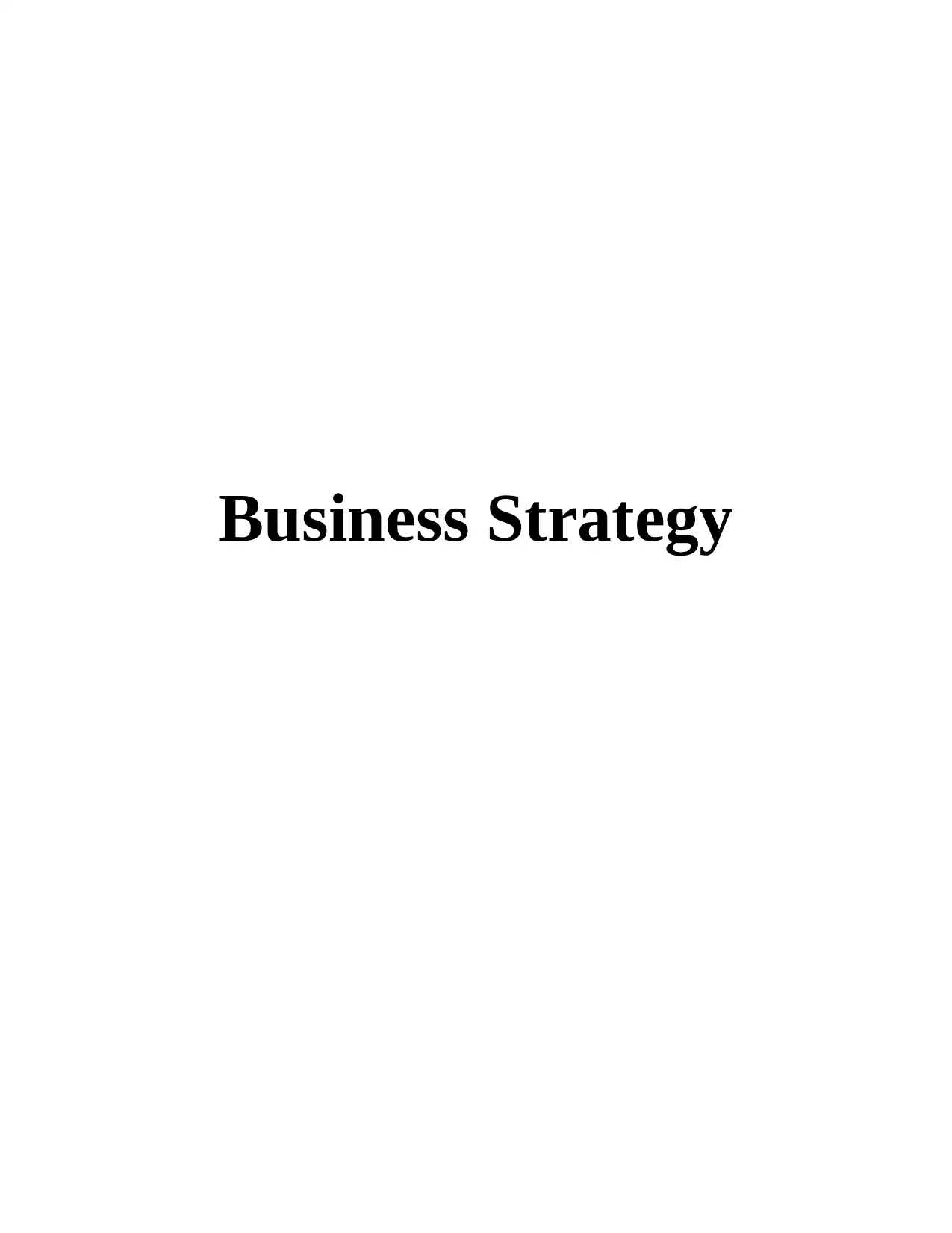
Business Strategy
Paraphrase This Document
Need a fresh take? Get an instant paraphrase of this document with our AI Paraphraser
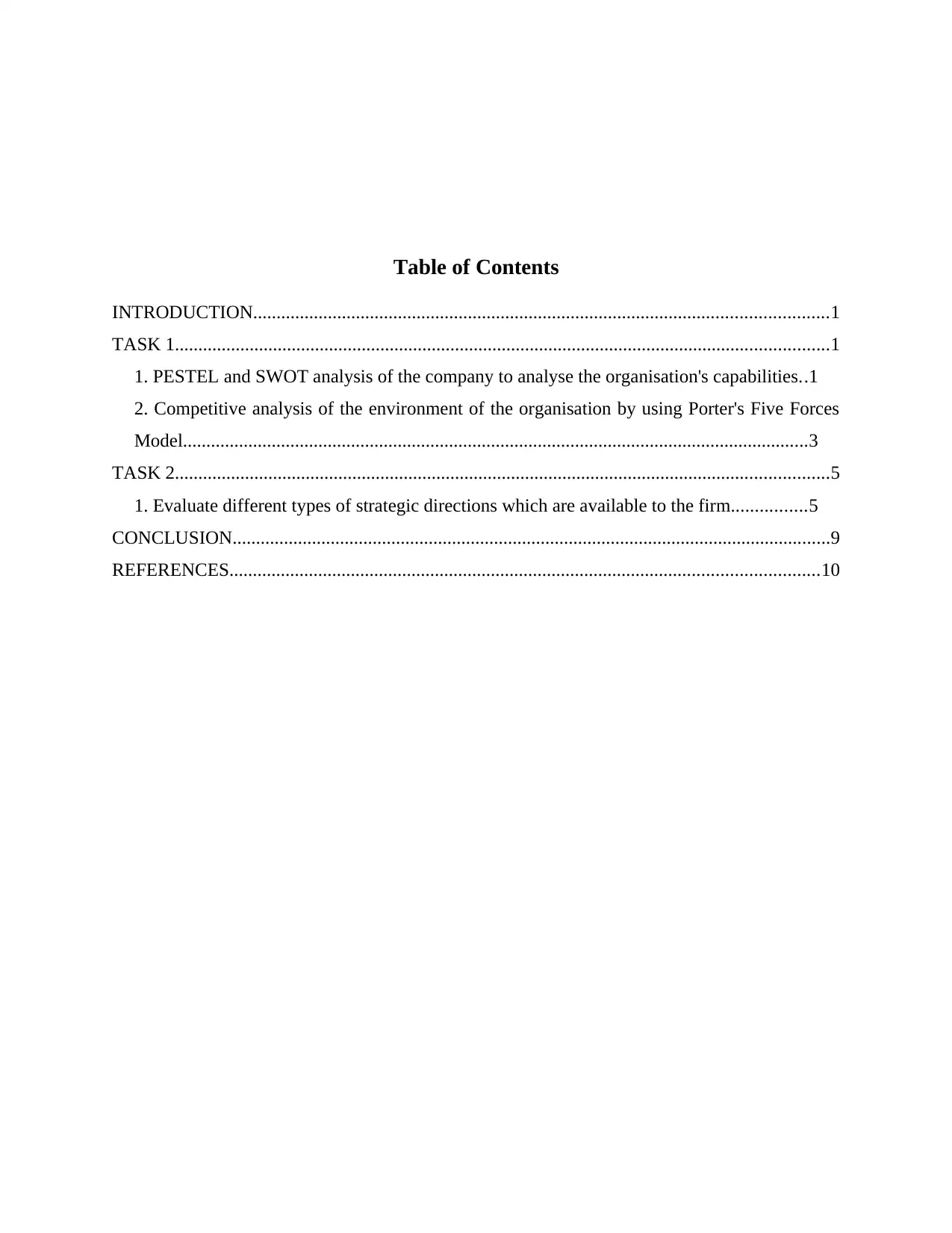
Table of Contents
INTRODUCTION...........................................................................................................................1
TASK 1............................................................................................................................................1
1. PESTEL and SWOT analysis of the company to analyse the organisation's capabilities..1
2. Competitive analysis of the environment of the organisation by using Porter's Five Forces
Model......................................................................................................................................3
TASK 2............................................................................................................................................5
1. Evaluate different types of strategic directions which are available to the firm................5
CONCLUSION................................................................................................................................9
REFERENCES..............................................................................................................................10
INTRODUCTION...........................................................................................................................1
TASK 1............................................................................................................................................1
1. PESTEL and SWOT analysis of the company to analyse the organisation's capabilities..1
2. Competitive analysis of the environment of the organisation by using Porter's Five Forces
Model......................................................................................................................................3
TASK 2............................................................................................................................................5
1. Evaluate different types of strategic directions which are available to the firm................5
CONCLUSION................................................................................................................................9
REFERENCES..............................................................................................................................10
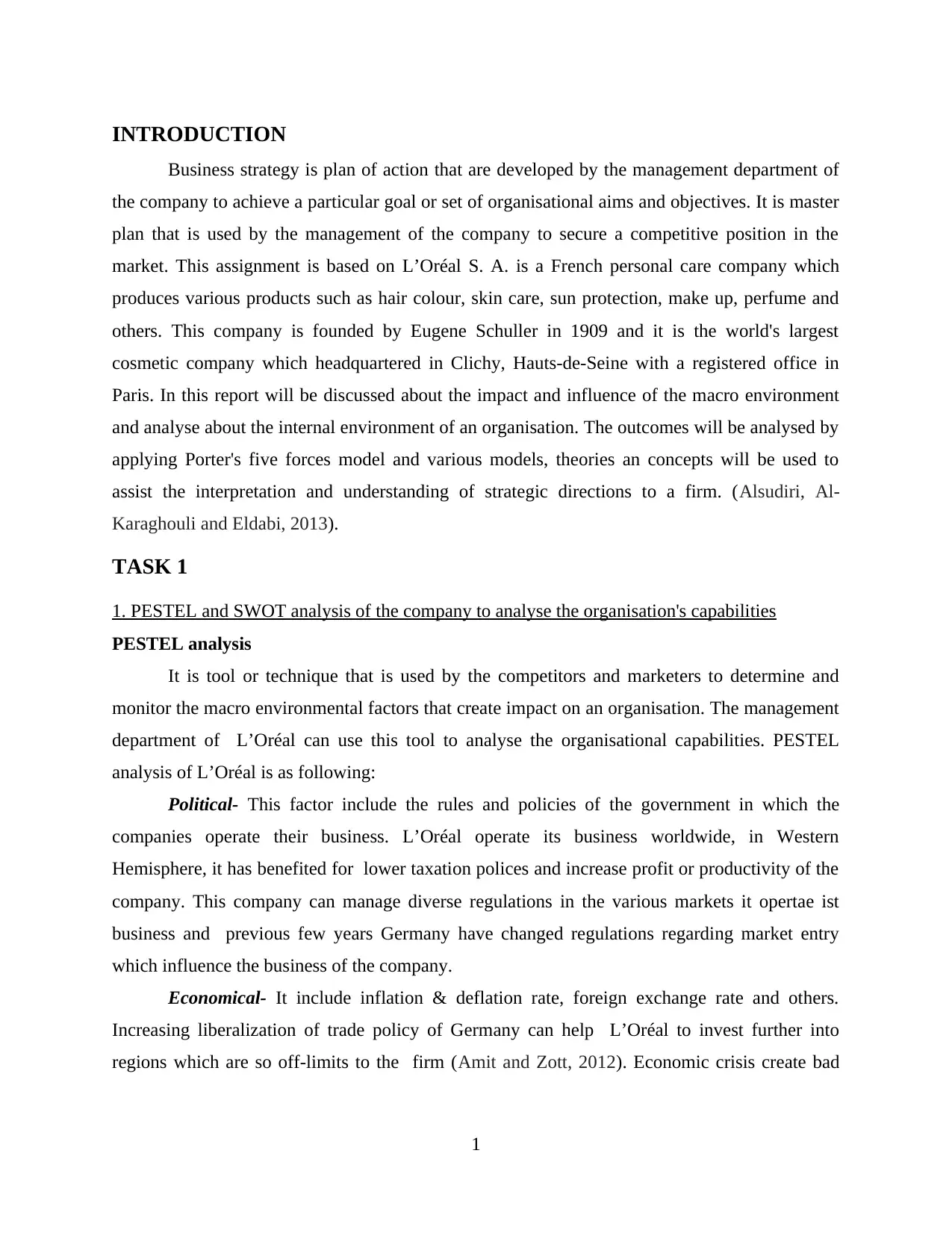
INTRODUCTION
Business strategy is plan of action that are developed by the management department of
the company to achieve a particular goal or set of organisational aims and objectives. It is master
plan that is used by the management of the company to secure a competitive position in the
market. This assignment is based on L’Oréal S. A. is a French personal care company which
produces various products such as hair colour, skin care, sun protection, make up, perfume and
others. This company is founded by Eugene Schuller in 1909 and it is the world's largest
cosmetic company which headquartered in Clichy, Hauts-de-Seine with a registered office in
Paris. In this report will be discussed about the impact and influence of the macro environment
and analyse about the internal environment of an organisation. The outcomes will be analysed by
applying Porter's five forces model and various models, theories an concepts will be used to
assist the interpretation and understanding of strategic directions to a firm. (Alsudiri, Al-
Karaghouli and Eldabi, 2013).
TASK 1
1. PESTEL and SWOT analysis of the company to analyse the organisation's capabilities
PESTEL analysis
It is tool or technique that is used by the competitors and marketers to determine and
monitor the macro environmental factors that create impact on an organisation. The management
department of L’Oréal can use this tool to analyse the organisational capabilities. PESTEL
analysis of L’Oréal is as following:
Political- This factor include the rules and policies of the government in which the
companies operate their business. L’Oréal operate its business worldwide, in Western
Hemisphere, it has benefited for lower taxation polices and increase profit or productivity of the
company. This company can manage diverse regulations in the various markets it opertae ist
business and previous few years Germany have changed regulations regarding market entry
which influence the business of the company.
Economical- It include inflation & deflation rate, foreign exchange rate and others.
Increasing liberalization of trade policy of Germany can help L’Oréal to invest further into
regions which are so off-limits to the firm (Amit and Zott, 2012). Economic crisis create bad
1
Business strategy is plan of action that are developed by the management department of
the company to achieve a particular goal or set of organisational aims and objectives. It is master
plan that is used by the management of the company to secure a competitive position in the
market. This assignment is based on L’Oréal S. A. is a French personal care company which
produces various products such as hair colour, skin care, sun protection, make up, perfume and
others. This company is founded by Eugene Schuller in 1909 and it is the world's largest
cosmetic company which headquartered in Clichy, Hauts-de-Seine with a registered office in
Paris. In this report will be discussed about the impact and influence of the macro environment
and analyse about the internal environment of an organisation. The outcomes will be analysed by
applying Porter's five forces model and various models, theories an concepts will be used to
assist the interpretation and understanding of strategic directions to a firm. (Alsudiri, Al-
Karaghouli and Eldabi, 2013).
TASK 1
1. PESTEL and SWOT analysis of the company to analyse the organisation's capabilities
PESTEL analysis
It is tool or technique that is used by the competitors and marketers to determine and
monitor the macro environmental factors that create impact on an organisation. The management
department of L’Oréal can use this tool to analyse the organisational capabilities. PESTEL
analysis of L’Oréal is as following:
Political- This factor include the rules and policies of the government in which the
companies operate their business. L’Oréal operate its business worldwide, in Western
Hemisphere, it has benefited for lower taxation polices and increase profit or productivity of the
company. This company can manage diverse regulations in the various markets it opertae ist
business and previous few years Germany have changed regulations regarding market entry
which influence the business of the company.
Economical- It include inflation & deflation rate, foreign exchange rate and others.
Increasing liberalization of trade policy of Germany can help L’Oréal to invest further into
regions which are so off-limits to the firm (Amit and Zott, 2012). Economic crisis create bad
1
⊘ This is a preview!⊘
Do you want full access?
Subscribe today to unlock all pages.

Trusted by 1+ million students worldwide
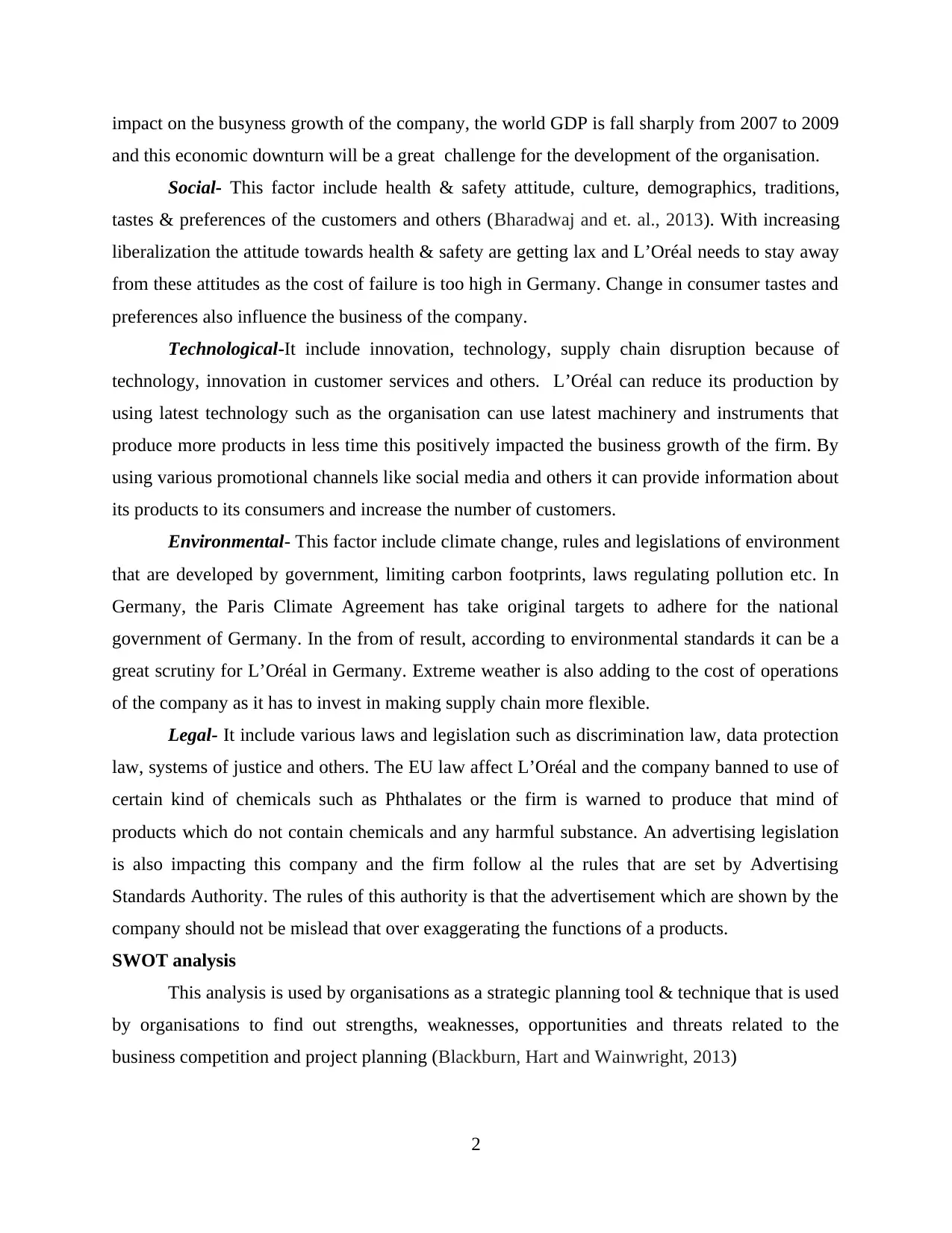
impact on the busyness growth of the company, the world GDP is fall sharply from 2007 to 2009
and this economic downturn will be a great challenge for the development of the organisation.
Social- This factor include health & safety attitude, culture, demographics, traditions,
tastes & preferences of the customers and others (Bharadwaj and et. al., 2013). With increasing
liberalization the attitude towards health & safety are getting lax and L’Oréal needs to stay away
from these attitudes as the cost of failure is too high in Germany. Change in consumer tastes and
preferences also influence the business of the company.
Technological-It include innovation, technology, supply chain disruption because of
technology, innovation in customer services and others. L’Oréal can reduce its production by
using latest technology such as the organisation can use latest machinery and instruments that
produce more products in less time this positively impacted the business growth of the firm. By
using various promotional channels like social media and others it can provide information about
its products to its consumers and increase the number of customers.
Environmental- This factor include climate change, rules and legislations of environment
that are developed by government, limiting carbon footprints, laws regulating pollution etc. In
Germany, the Paris Climate Agreement has take original targets to adhere for the national
government of Germany. In the from of result, according to environmental standards it can be a
great scrutiny for L’Oréal in Germany. Extreme weather is also adding to the cost of operations
of the company as it has to invest in making supply chain more flexible.
Legal- It include various laws and legislation such as discrimination law, data protection
law, systems of justice and others. The EU law affect L’Oréal and the company banned to use of
certain kind of chemicals such as Phthalates or the firm is warned to produce that mind of
products which do not contain chemicals and any harmful substance. An advertising legislation
is also impacting this company and the firm follow al the rules that are set by Advertising
Standards Authority. The rules of this authority is that the advertisement which are shown by the
company should not be mislead that over exaggerating the functions of a products.
SWOT analysis
This analysis is used by organisations as a strategic planning tool & technique that is used
by organisations to find out strengths, weaknesses, opportunities and threats related to the
business competition and project planning (Blackburn, Hart and Wainwright, 2013)
2
and this economic downturn will be a great challenge for the development of the organisation.
Social- This factor include health & safety attitude, culture, demographics, traditions,
tastes & preferences of the customers and others (Bharadwaj and et. al., 2013). With increasing
liberalization the attitude towards health & safety are getting lax and L’Oréal needs to stay away
from these attitudes as the cost of failure is too high in Germany. Change in consumer tastes and
preferences also influence the business of the company.
Technological-It include innovation, technology, supply chain disruption because of
technology, innovation in customer services and others. L’Oréal can reduce its production by
using latest technology such as the organisation can use latest machinery and instruments that
produce more products in less time this positively impacted the business growth of the firm. By
using various promotional channels like social media and others it can provide information about
its products to its consumers and increase the number of customers.
Environmental- This factor include climate change, rules and legislations of environment
that are developed by government, limiting carbon footprints, laws regulating pollution etc. In
Germany, the Paris Climate Agreement has take original targets to adhere for the national
government of Germany. In the from of result, according to environmental standards it can be a
great scrutiny for L’Oréal in Germany. Extreme weather is also adding to the cost of operations
of the company as it has to invest in making supply chain more flexible.
Legal- It include various laws and legislation such as discrimination law, data protection
law, systems of justice and others. The EU law affect L’Oréal and the company banned to use of
certain kind of chemicals such as Phthalates or the firm is warned to produce that mind of
products which do not contain chemicals and any harmful substance. An advertising legislation
is also impacting this company and the firm follow al the rules that are set by Advertising
Standards Authority. The rules of this authority is that the advertisement which are shown by the
company should not be mislead that over exaggerating the functions of a products.
SWOT analysis
This analysis is used by organisations as a strategic planning tool & technique that is used
by organisations to find out strengths, weaknesses, opportunities and threats related to the
business competition and project planning (Blackburn, Hart and Wainwright, 2013)
2
Paraphrase This Document
Need a fresh take? Get an instant paraphrase of this document with our AI Paraphraser
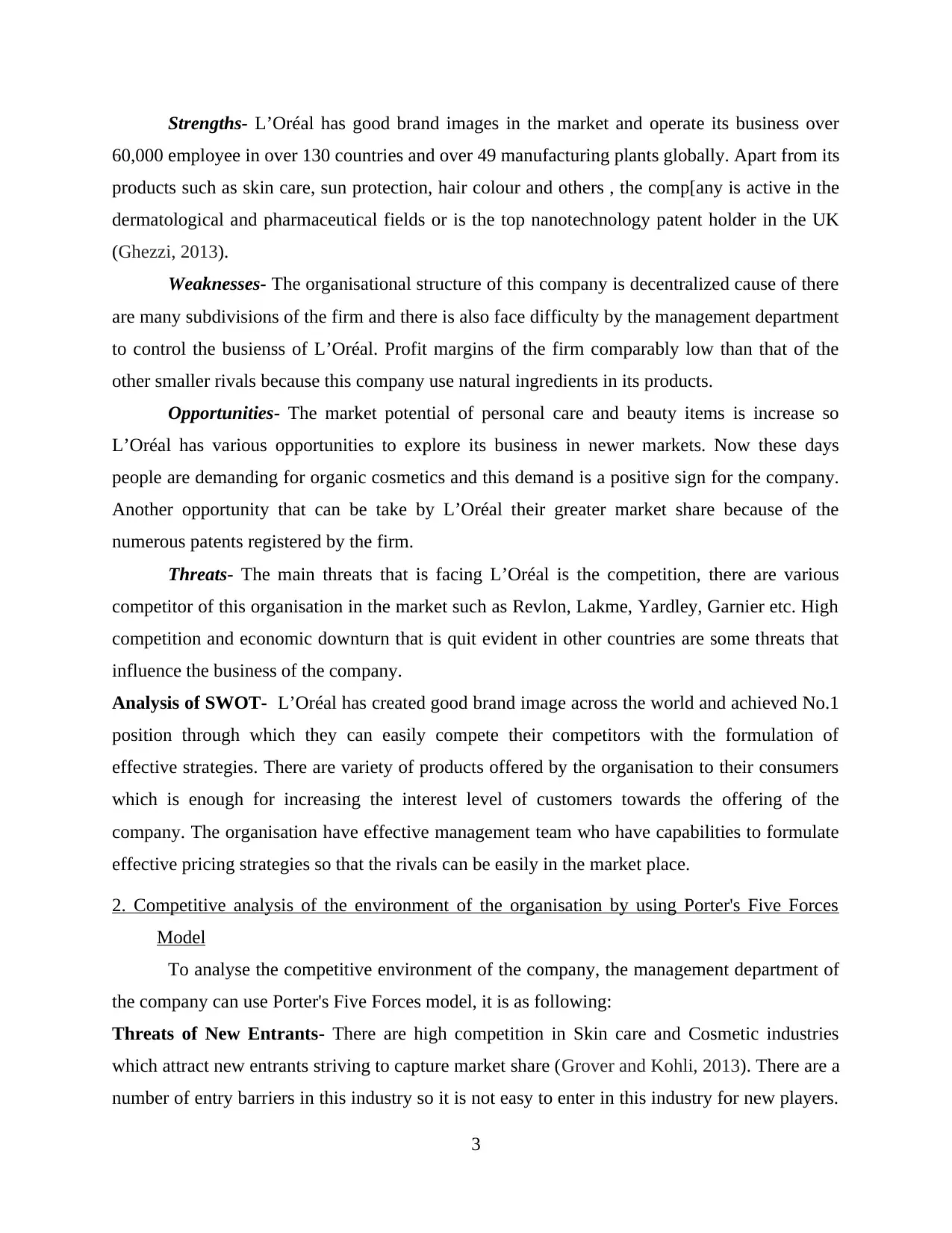
Strengths- L’Oréal has good brand images in the market and operate its business over
60,000 employee in over 130 countries and over 49 manufacturing plants globally. Apart from its
products such as skin care, sun protection, hair colour and others , the comp[any is active in the
dermatological and pharmaceutical fields or is the top nanotechnology patent holder in the UK
(Ghezzi, 2013).
Weaknesses- The organisational structure of this company is decentralized cause of there
are many subdivisions of the firm and there is also face difficulty by the management department
to control the busienss of L’Oréal. Profit margins of the firm comparably low than that of the
other smaller rivals because this company use natural ingredients in its products.
Opportunities- The market potential of personal care and beauty items is increase so
L’Oréal has various opportunities to explore its business in newer markets. Now these days
people are demanding for organic cosmetics and this demand is a positive sign for the company.
Another opportunity that can be take by L’Oréal their greater market share because of the
numerous patents registered by the firm.
Threats- The main threats that is facing L’Oréal is the competition, there are various
competitor of this organisation in the market such as Revlon, Lakme, Yardley, Garnier etc. High
competition and economic downturn that is quit evident in other countries are some threats that
influence the business of the company.
Analysis of SWOT- L’Oréal has created good brand image across the world and achieved No.1
position through which they can easily compete their competitors with the formulation of
effective strategies. There are variety of products offered by the organisation to their consumers
which is enough for increasing the interest level of customers towards the offering of the
company. The organisation have effective management team who have capabilities to formulate
effective pricing strategies so that the rivals can be easily in the market place.
2. Competitive analysis of the environment of the organisation by using Porter's Five Forces
Model
To analyse the competitive environment of the company, the management department of
the company can use Porter's Five Forces model, it is as following:
Threats of New Entrants- There are high competition in Skin care and Cosmetic industries
which attract new entrants striving to capture market share (Grover and Kohli, 2013). There are a
number of entry barriers in this industry so it is not easy to enter in this industry for new players.
3
60,000 employee in over 130 countries and over 49 manufacturing plants globally. Apart from its
products such as skin care, sun protection, hair colour and others , the comp[any is active in the
dermatological and pharmaceutical fields or is the top nanotechnology patent holder in the UK
(Ghezzi, 2013).
Weaknesses- The organisational structure of this company is decentralized cause of there
are many subdivisions of the firm and there is also face difficulty by the management department
to control the busienss of L’Oréal. Profit margins of the firm comparably low than that of the
other smaller rivals because this company use natural ingredients in its products.
Opportunities- The market potential of personal care and beauty items is increase so
L’Oréal has various opportunities to explore its business in newer markets. Now these days
people are demanding for organic cosmetics and this demand is a positive sign for the company.
Another opportunity that can be take by L’Oréal their greater market share because of the
numerous patents registered by the firm.
Threats- The main threats that is facing L’Oréal is the competition, there are various
competitor of this organisation in the market such as Revlon, Lakme, Yardley, Garnier etc. High
competition and economic downturn that is quit evident in other countries are some threats that
influence the business of the company.
Analysis of SWOT- L’Oréal has created good brand image across the world and achieved No.1
position through which they can easily compete their competitors with the formulation of
effective strategies. There are variety of products offered by the organisation to their consumers
which is enough for increasing the interest level of customers towards the offering of the
company. The organisation have effective management team who have capabilities to formulate
effective pricing strategies so that the rivals can be easily in the market place.
2. Competitive analysis of the environment of the organisation by using Porter's Five Forces
Model
To analyse the competitive environment of the company, the management department of
the company can use Porter's Five Forces model, it is as following:
Threats of New Entrants- There are high competition in Skin care and Cosmetic industries
which attract new entrants striving to capture market share (Grover and Kohli, 2013). There are a
number of entry barriers in this industry so it is not easy to enter in this industry for new players.
3
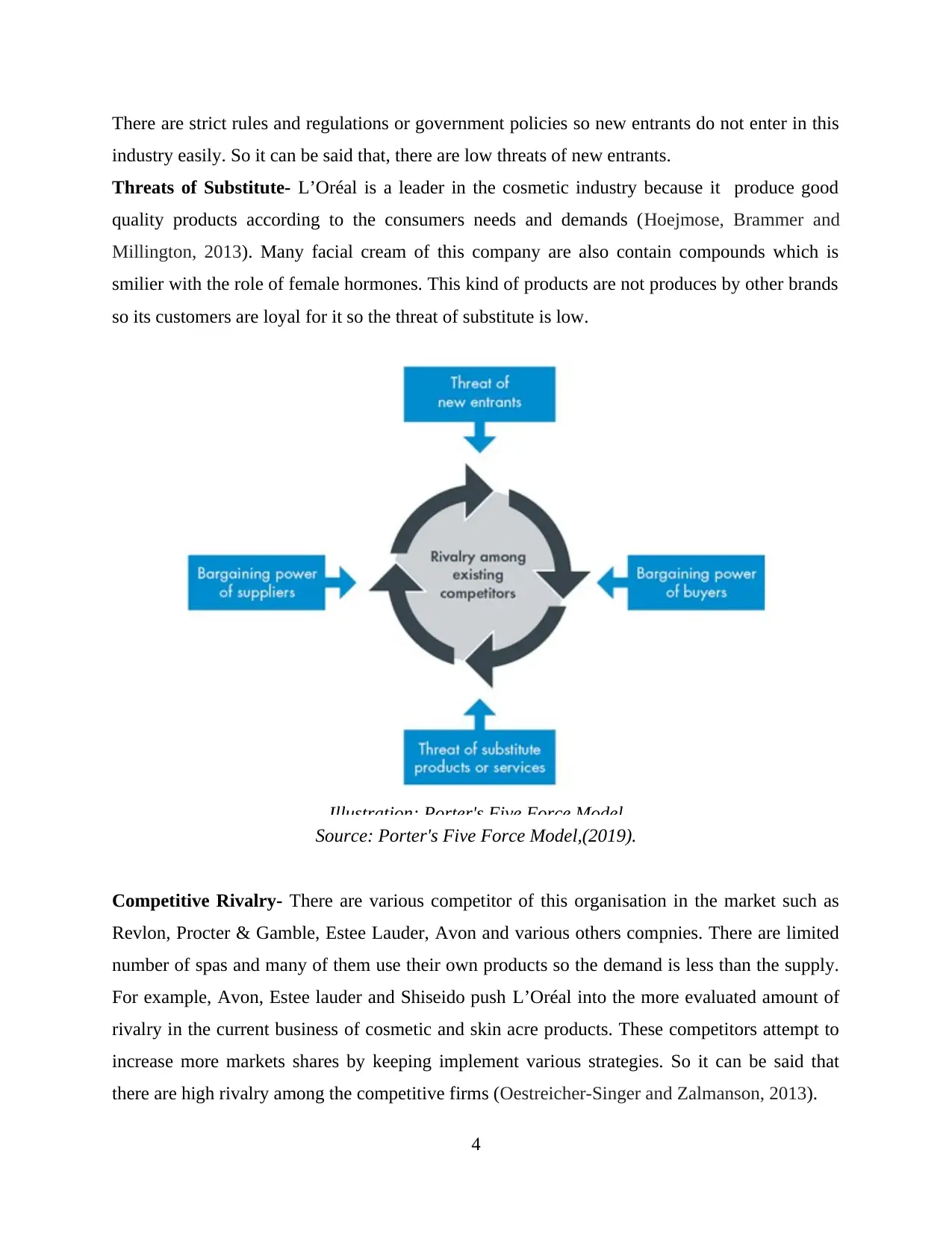
There are strict rules and regulations or government policies so new entrants do not enter in this
industry easily. So it can be said that, there are low threats of new entrants.
Threats of Substitute- L’Oréal is a leader in the cosmetic industry because it produce good
quality products according to the consumers needs and demands (Hoejmose, Brammer and
Millington, 2013). Many facial cream of this company are also contain compounds which is
smilier with the role of female hormones. This kind of products are not produces by other brands
so its customers are loyal for it so the threat of substitute is low.
Source: Porter's Five Force Model,(2019).
Competitive Rivalry- There are various competitor of this organisation in the market such as
Revlon, Procter & Gamble, Estee Lauder, Avon and various others compnies. There are limited
number of spas and many of them use their own products so the demand is less than the supply.
For example, Avon, Estee lauder and Shiseido push L’Oréal into the more evaluated amount of
rivalry in the current business of cosmetic and skin acre products. These competitors attempt to
increase more markets shares by keeping implement various strategies. So it can be said that
there are high rivalry among the competitive firms (Oestreicher-Singer and Zalmanson, 2013).
4
Illustration: Porter's Five Force Model
industry easily. So it can be said that, there are low threats of new entrants.
Threats of Substitute- L’Oréal is a leader in the cosmetic industry because it produce good
quality products according to the consumers needs and demands (Hoejmose, Brammer and
Millington, 2013). Many facial cream of this company are also contain compounds which is
smilier with the role of female hormones. This kind of products are not produces by other brands
so its customers are loyal for it so the threat of substitute is low.
Source: Porter's Five Force Model,(2019).
Competitive Rivalry- There are various competitor of this organisation in the market such as
Revlon, Procter & Gamble, Estee Lauder, Avon and various others compnies. There are limited
number of spas and many of them use their own products so the demand is less than the supply.
For example, Avon, Estee lauder and Shiseido push L’Oréal into the more evaluated amount of
rivalry in the current business of cosmetic and skin acre products. These competitors attempt to
increase more markets shares by keeping implement various strategies. So it can be said that
there are high rivalry among the competitive firms (Oestreicher-Singer and Zalmanson, 2013).
4
Illustration: Porter's Five Force Model
⊘ This is a preview!⊘
Do you want full access?
Subscribe today to unlock all pages.

Trusted by 1+ million students worldwide
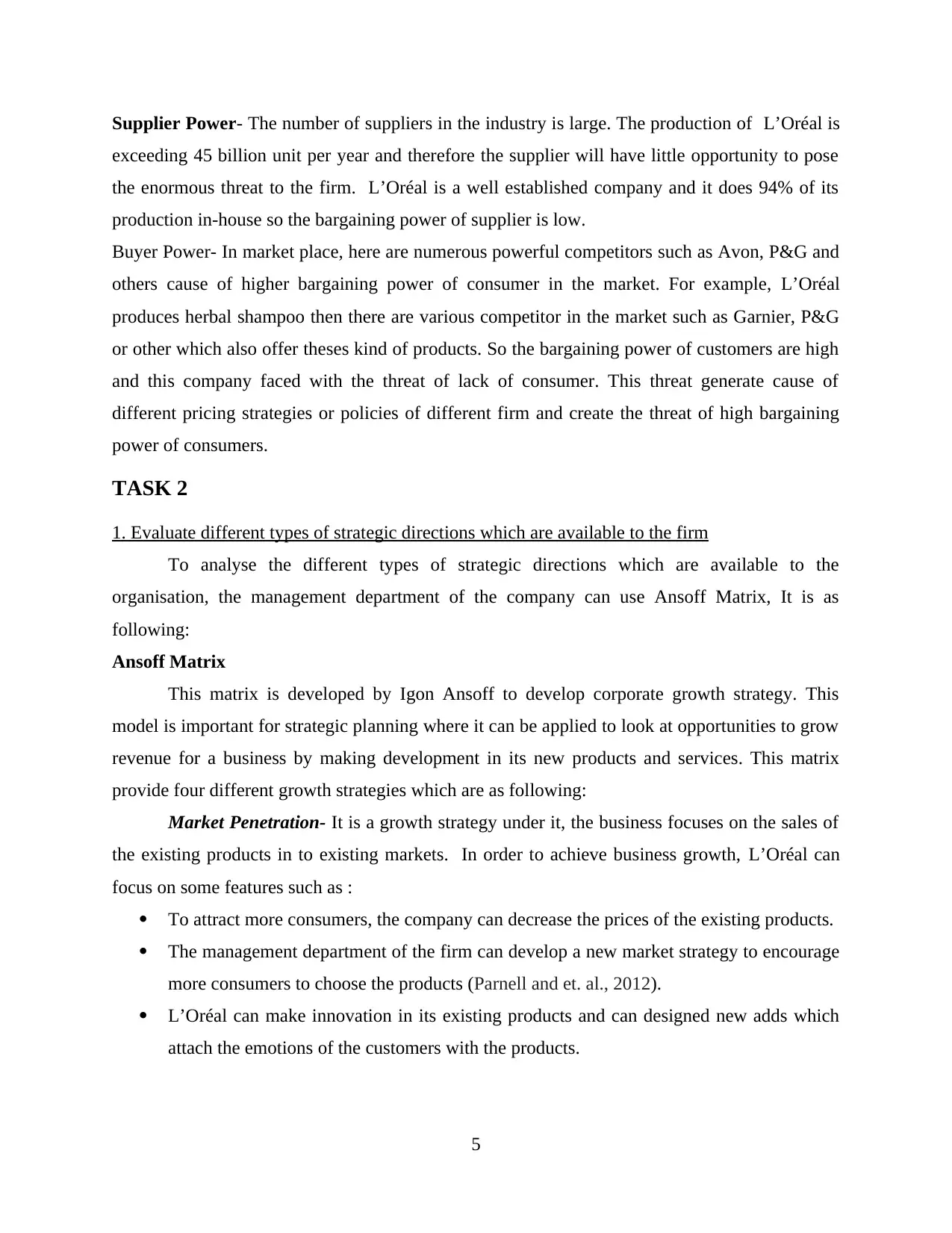
Supplier Power- The number of suppliers in the industry is large. The production of L’Oréal is
exceeding 45 billion unit per year and therefore the supplier will have little opportunity to pose
the enormous threat to the firm. L’Oréal is a well established company and it does 94% of its
production in-house so the bargaining power of supplier is low.
Buyer Power- In market place, here are numerous powerful competitors such as Avon, P&G and
others cause of higher bargaining power of consumer in the market. For example, L’Oréal
produces herbal shampoo then there are various competitor in the market such as Garnier, P&G
or other which also offer theses kind of products. So the bargaining power of customers are high
and this company faced with the threat of lack of consumer. This threat generate cause of
different pricing strategies or policies of different firm and create the threat of high bargaining
power of consumers.
TASK 2
1. Evaluate different types of strategic directions which are available to the firm
To analyse the different types of strategic directions which are available to the
organisation, the management department of the company can use Ansoff Matrix, It is as
following:
Ansoff Matrix
This matrix is developed by Igon Ansoff to develop corporate growth strategy. This
model is important for strategic planning where it can be applied to look at opportunities to grow
revenue for a business by making development in its new products and services. This matrix
provide four different growth strategies which are as following:
Market Penetration- It is a growth strategy under it, the business focuses on the sales of
the existing products in to existing markets. In order to achieve business growth, L’Oréal can
focus on some features such as :
To attract more consumers, the company can decrease the prices of the existing products.
The management department of the firm can develop a new market strategy to encourage
more consumers to choose the products (Parnell and et. al., 2012).
L’Oréal can make innovation in its existing products and can designed new adds which
attach the emotions of the customers with the products.
5
exceeding 45 billion unit per year and therefore the supplier will have little opportunity to pose
the enormous threat to the firm. L’Oréal is a well established company and it does 94% of its
production in-house so the bargaining power of supplier is low.
Buyer Power- In market place, here are numerous powerful competitors such as Avon, P&G and
others cause of higher bargaining power of consumer in the market. For example, L’Oréal
produces herbal shampoo then there are various competitor in the market such as Garnier, P&G
or other which also offer theses kind of products. So the bargaining power of customers are high
and this company faced with the threat of lack of consumer. This threat generate cause of
different pricing strategies or policies of different firm and create the threat of high bargaining
power of consumers.
TASK 2
1. Evaluate different types of strategic directions which are available to the firm
To analyse the different types of strategic directions which are available to the
organisation, the management department of the company can use Ansoff Matrix, It is as
following:
Ansoff Matrix
This matrix is developed by Igon Ansoff to develop corporate growth strategy. This
model is important for strategic planning where it can be applied to look at opportunities to grow
revenue for a business by making development in its new products and services. This matrix
provide four different growth strategies which are as following:
Market Penetration- It is a growth strategy under it, the business focuses on the sales of
the existing products in to existing markets. In order to achieve business growth, L’Oréal can
focus on some features such as :
To attract more consumers, the company can decrease the prices of the existing products.
The management department of the firm can develop a new market strategy to encourage
more consumers to choose the products (Parnell and et. al., 2012).
L’Oréal can make innovation in its existing products and can designed new adds which
attach the emotions of the customers with the products.
5
Paraphrase This Document
Need a fresh take? Get an instant paraphrase of this document with our AI Paraphraser
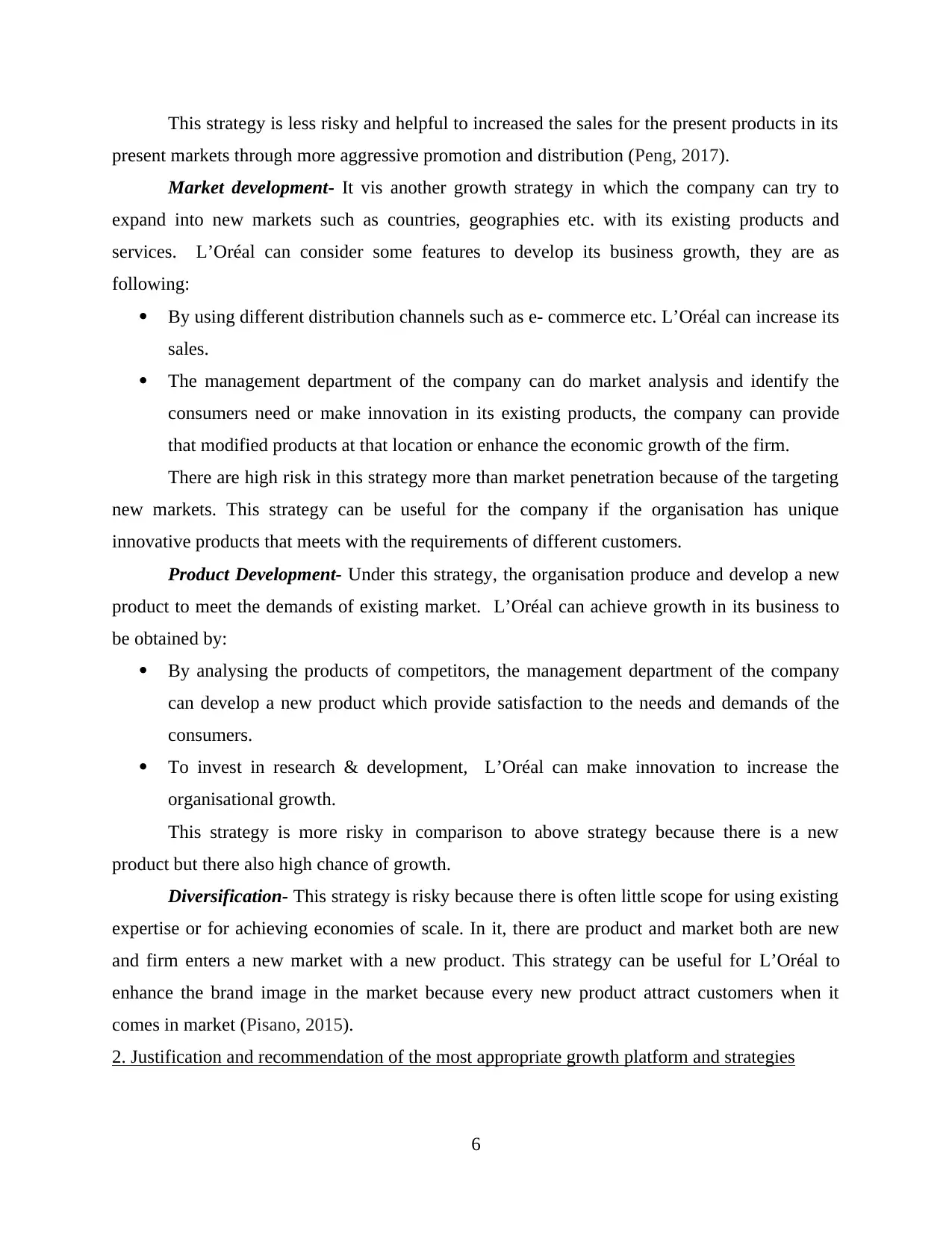
This strategy is less risky and helpful to increased the sales for the present products in its
present markets through more aggressive promotion and distribution (Peng, 2017).
Market development- It vis another growth strategy in which the company can try to
expand into new markets such as countries, geographies etc. with its existing products and
services. L’Oréal can consider some features to develop its business growth, they are as
following:
By using different distribution channels such as e- commerce etc. L’Oréal can increase its
sales.
The management department of the company can do market analysis and identify the
consumers need or make innovation in its existing products, the company can provide
that modified products at that location or enhance the economic growth of the firm.
There are high risk in this strategy more than market penetration because of the targeting
new markets. This strategy can be useful for the company if the organisation has unique
innovative products that meets with the requirements of different customers.
Product Development- Under this strategy, the organisation produce and develop a new
product to meet the demands of existing market. L’Oréal can achieve growth in its business to
be obtained by:
By analysing the products of competitors, the management department of the company
can develop a new product which provide satisfaction to the needs and demands of the
consumers.
To invest in research & development, L’Oréal can make innovation to increase the
organisational growth.
This strategy is more risky in comparison to above strategy because there is a new
product but there also high chance of growth.
Diversification- This strategy is risky because there is often little scope for using existing
expertise or for achieving economies of scale. In it, there are product and market both are new
and firm enters a new market with a new product. This strategy can be useful for L’Oréal to
enhance the brand image in the market because every new product attract customers when it
comes in market (Pisano, 2015).
2. Justification and recommendation of the most appropriate growth platform and strategies
6
present markets through more aggressive promotion and distribution (Peng, 2017).
Market development- It vis another growth strategy in which the company can try to
expand into new markets such as countries, geographies etc. with its existing products and
services. L’Oréal can consider some features to develop its business growth, they are as
following:
By using different distribution channels such as e- commerce etc. L’Oréal can increase its
sales.
The management department of the company can do market analysis and identify the
consumers need or make innovation in its existing products, the company can provide
that modified products at that location or enhance the economic growth of the firm.
There are high risk in this strategy more than market penetration because of the targeting
new markets. This strategy can be useful for the company if the organisation has unique
innovative products that meets with the requirements of different customers.
Product Development- Under this strategy, the organisation produce and develop a new
product to meet the demands of existing market. L’Oréal can achieve growth in its business to
be obtained by:
By analysing the products of competitors, the management department of the company
can develop a new product which provide satisfaction to the needs and demands of the
consumers.
To invest in research & development, L’Oréal can make innovation to increase the
organisational growth.
This strategy is more risky in comparison to above strategy because there is a new
product but there also high chance of growth.
Diversification- This strategy is risky because there is often little scope for using existing
expertise or for achieving economies of scale. In it, there are product and market both are new
and firm enters a new market with a new product. This strategy can be useful for L’Oréal to
enhance the brand image in the market because every new product attract customers when it
comes in market (Pisano, 2015).
2. Justification and recommendation of the most appropriate growth platform and strategies
6
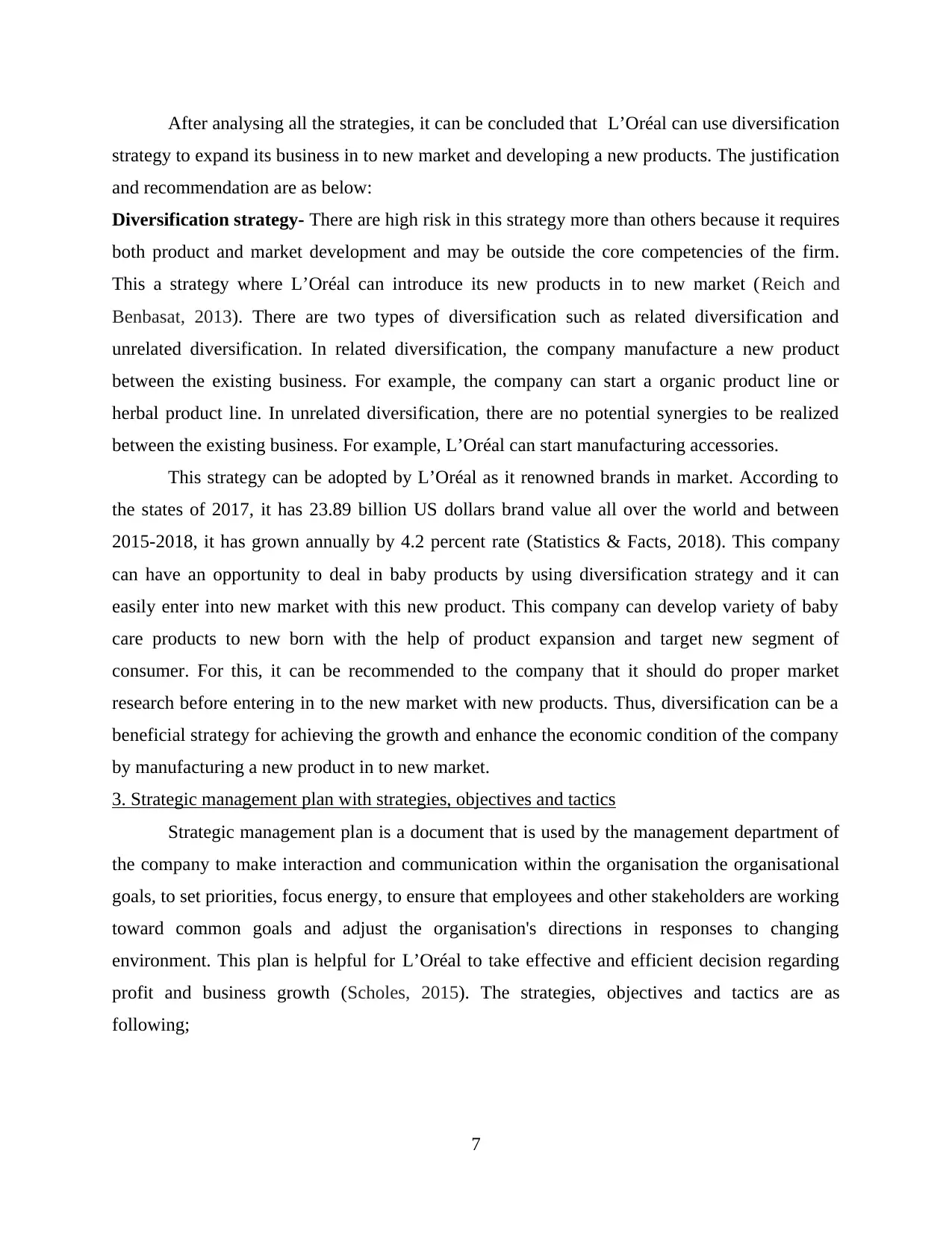
After analysing all the strategies, it can be concluded that L’Oréal can use diversification
strategy to expand its business in to new market and developing a new products. The justification
and recommendation are as below:
Diversification strategy- There are high risk in this strategy more than others because it requires
both product and market development and may be outside the core competencies of the firm.
This a strategy where L’Oréal can introduce its new products in to new market (Reich and
Benbasat, 2013). There are two types of diversification such as related diversification and
unrelated diversification. In related diversification, the company manufacture a new product
between the existing business. For example, the company can start a organic product line or
herbal product line. In unrelated diversification, there are no potential synergies to be realized
between the existing business. For example, L’Oréal can start manufacturing accessories.
This strategy can be adopted by L’Oréal as it renowned brands in market. According to
the states of 2017, it has 23.89 billion US dollars brand value all over the world and between
2015-2018, it has grown annually by 4.2 percent rate (Statistics & Facts, 2018). This company
can have an opportunity to deal in baby products by using diversification strategy and it can
easily enter into new market with this new product. This company can develop variety of baby
care products to new born with the help of product expansion and target new segment of
consumer. For this, it can be recommended to the company that it should do proper market
research before entering in to the new market with new products. Thus, diversification can be a
beneficial strategy for achieving the growth and enhance the economic condition of the company
by manufacturing a new product in to new market.
3. Strategic management plan with strategies, objectives and tactics
Strategic management plan is a document that is used by the management department of
the company to make interaction and communication within the organisation the organisational
goals, to set priorities, focus energy, to ensure that employees and other stakeholders are working
toward common goals and adjust the organisation's directions in responses to changing
environment. This plan is helpful for L’Oréal to take effective and efficient decision regarding
profit and business growth (Scholes, 2015). The strategies, objectives and tactics are as
following;
7
strategy to expand its business in to new market and developing a new products. The justification
and recommendation are as below:
Diversification strategy- There are high risk in this strategy more than others because it requires
both product and market development and may be outside the core competencies of the firm.
This a strategy where L’Oréal can introduce its new products in to new market (Reich and
Benbasat, 2013). There are two types of diversification such as related diversification and
unrelated diversification. In related diversification, the company manufacture a new product
between the existing business. For example, the company can start a organic product line or
herbal product line. In unrelated diversification, there are no potential synergies to be realized
between the existing business. For example, L’Oréal can start manufacturing accessories.
This strategy can be adopted by L’Oréal as it renowned brands in market. According to
the states of 2017, it has 23.89 billion US dollars brand value all over the world and between
2015-2018, it has grown annually by 4.2 percent rate (Statistics & Facts, 2018). This company
can have an opportunity to deal in baby products by using diversification strategy and it can
easily enter into new market with this new product. This company can develop variety of baby
care products to new born with the help of product expansion and target new segment of
consumer. For this, it can be recommended to the company that it should do proper market
research before entering in to the new market with new products. Thus, diversification can be a
beneficial strategy for achieving the growth and enhance the economic condition of the company
by manufacturing a new product in to new market.
3. Strategic management plan with strategies, objectives and tactics
Strategic management plan is a document that is used by the management department of
the company to make interaction and communication within the organisation the organisational
goals, to set priorities, focus energy, to ensure that employees and other stakeholders are working
toward common goals and adjust the organisation's directions in responses to changing
environment. This plan is helpful for L’Oréal to take effective and efficient decision regarding
profit and business growth (Scholes, 2015). The strategies, objectives and tactics are as
following;
7
⊘ This is a preview!⊘
Do you want full access?
Subscribe today to unlock all pages.

Trusted by 1+ million students worldwide
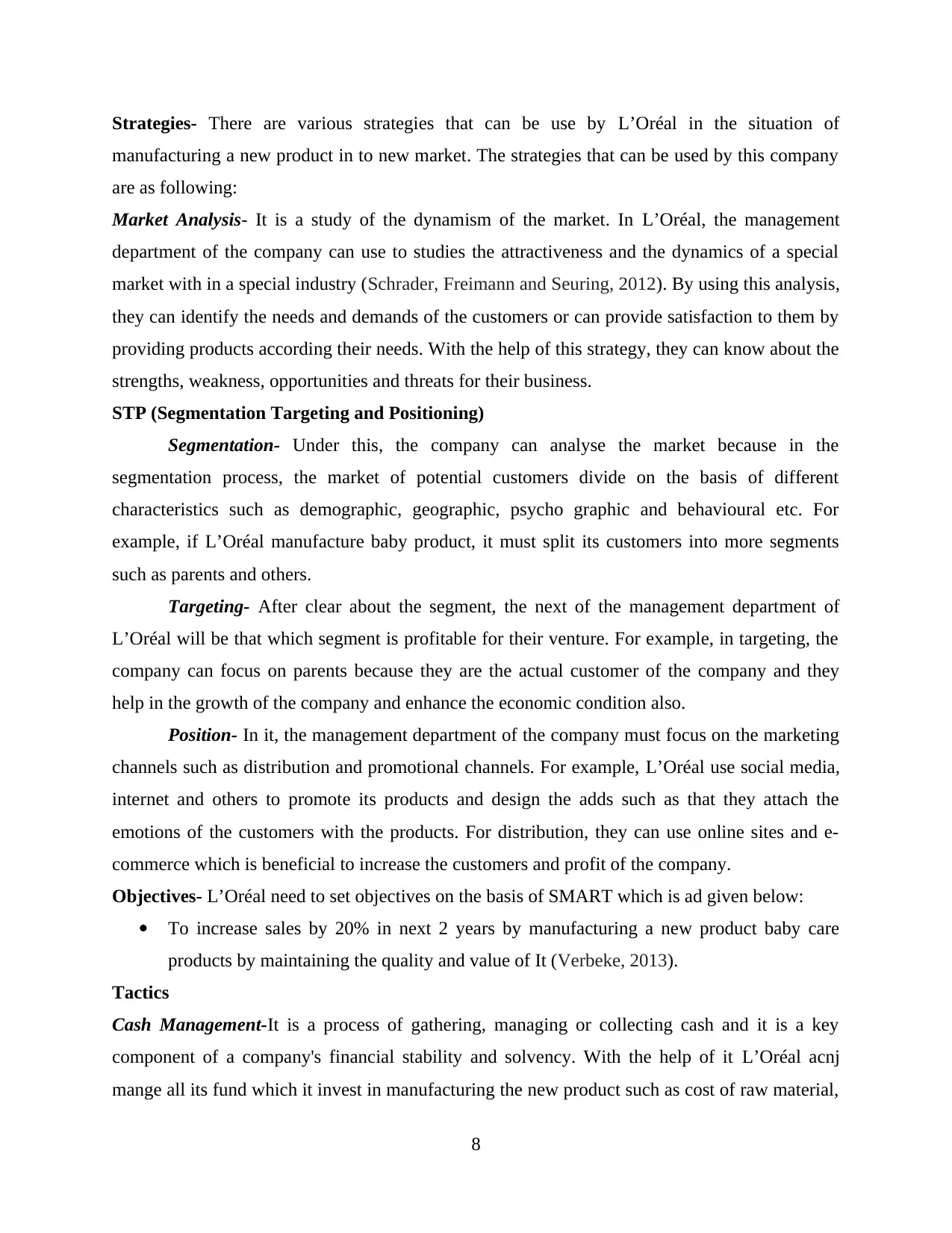
Strategies- There are various strategies that can be use by L’Oréal in the situation of
manufacturing a new product in to new market. The strategies that can be used by this company
are as following:
Market Analysis- It is a study of the dynamism of the market. In L’Oréal, the management
department of the company can use to studies the attractiveness and the dynamics of a special
market with in a special industry (Schrader, Freimann and Seuring, 2012). By using this analysis,
they can identify the needs and demands of the customers or can provide satisfaction to them by
providing products according their needs. With the help of this strategy, they can know about the
strengths, weakness, opportunities and threats for their business.
STP (Segmentation Targeting and Positioning)
Segmentation- Under this, the company can analyse the market because in the
segmentation process, the market of potential customers divide on the basis of different
characteristics such as demographic, geographic, psycho graphic and behavioural etc. For
example, if L’Oréal manufacture baby product, it must split its customers into more segments
such as parents and others.
Targeting- After clear about the segment, the next of the management department of
L’Oréal will be that which segment is profitable for their venture. For example, in targeting, the
company can focus on parents because they are the actual customer of the company and they
help in the growth of the company and enhance the economic condition also.
Position- In it, the management department of the company must focus on the marketing
channels such as distribution and promotional channels. For example, L’Oréal use social media,
internet and others to promote its products and design the adds such as that they attach the
emotions of the customers with the products. For distribution, they can use online sites and e-
commerce which is beneficial to increase the customers and profit of the company.
Objectives- L’Oréal need to set objectives on the basis of SMART which is ad given below:
To increase sales by 20% in next 2 years by manufacturing a new product baby care
products by maintaining the quality and value of It (Verbeke, 2013).
Tactics
Cash Management-It is a process of gathering, managing or collecting cash and it is a key
component of a company's financial stability and solvency. With the help of it L’Oréal acnj
mange all its fund which it invest in manufacturing the new product such as cost of raw material,
8
manufacturing a new product in to new market. The strategies that can be used by this company
are as following:
Market Analysis- It is a study of the dynamism of the market. In L’Oréal, the management
department of the company can use to studies the attractiveness and the dynamics of a special
market with in a special industry (Schrader, Freimann and Seuring, 2012). By using this analysis,
they can identify the needs and demands of the customers or can provide satisfaction to them by
providing products according their needs. With the help of this strategy, they can know about the
strengths, weakness, opportunities and threats for their business.
STP (Segmentation Targeting and Positioning)
Segmentation- Under this, the company can analyse the market because in the
segmentation process, the market of potential customers divide on the basis of different
characteristics such as demographic, geographic, psycho graphic and behavioural etc. For
example, if L’Oréal manufacture baby product, it must split its customers into more segments
such as parents and others.
Targeting- After clear about the segment, the next of the management department of
L’Oréal will be that which segment is profitable for their venture. For example, in targeting, the
company can focus on parents because they are the actual customer of the company and they
help in the growth of the company and enhance the economic condition also.
Position- In it, the management department of the company must focus on the marketing
channels such as distribution and promotional channels. For example, L’Oréal use social media,
internet and others to promote its products and design the adds such as that they attach the
emotions of the customers with the products. For distribution, they can use online sites and e-
commerce which is beneficial to increase the customers and profit of the company.
Objectives- L’Oréal need to set objectives on the basis of SMART which is ad given below:
To increase sales by 20% in next 2 years by manufacturing a new product baby care
products by maintaining the quality and value of It (Verbeke, 2013).
Tactics
Cash Management-It is a process of gathering, managing or collecting cash and it is a key
component of a company's financial stability and solvency. With the help of it L’Oréal acnj
mange all its fund which it invest in manufacturing the new product such as cost of raw material,
8
Paraphrase This Document
Need a fresh take? Get an instant paraphrase of this document with our AI Paraphraser
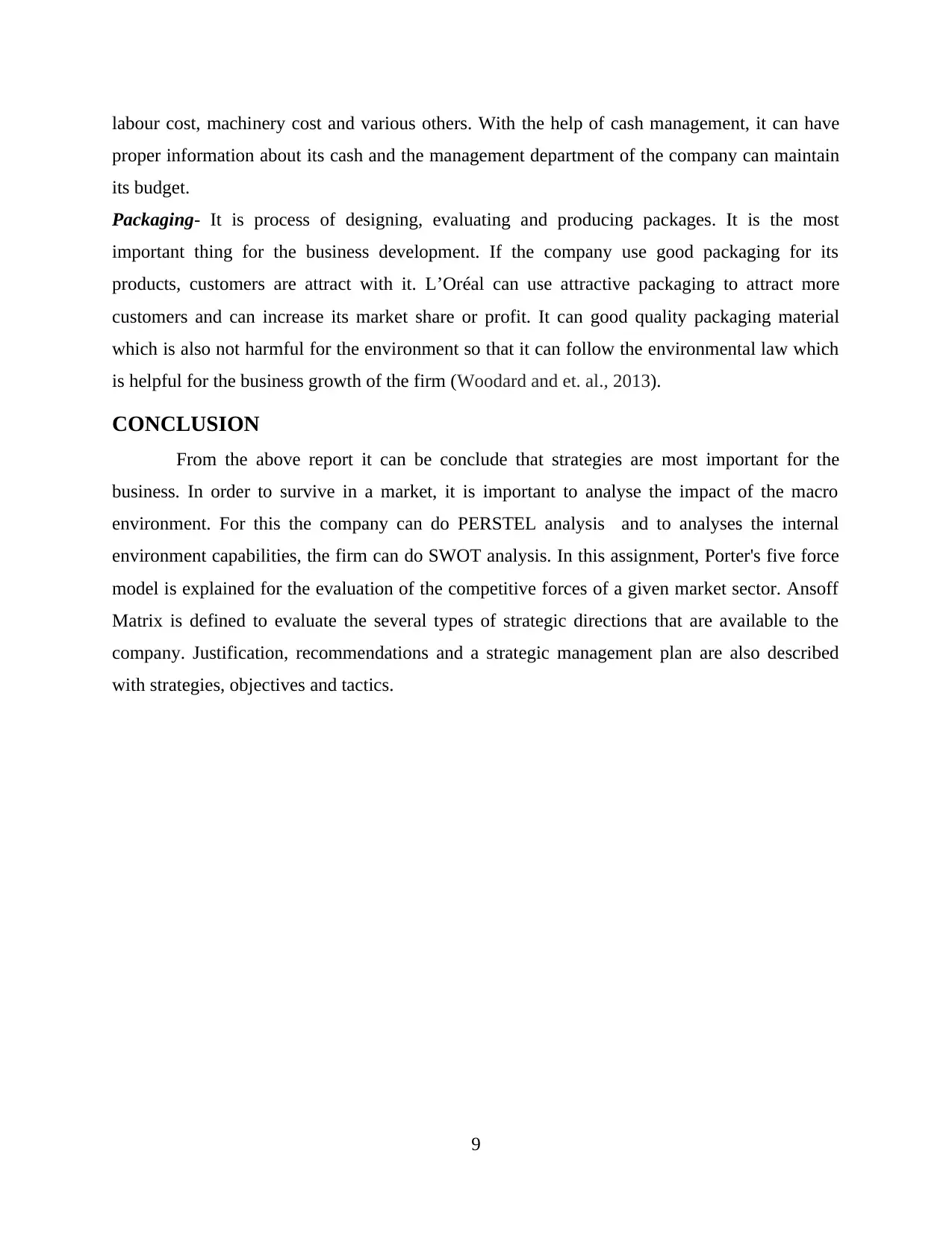
labour cost, machinery cost and various others. With the help of cash management, it can have
proper information about its cash and the management department of the company can maintain
its budget.
Packaging- It is process of designing, evaluating and producing packages. It is the most
important thing for the business development. If the company use good packaging for its
products, customers are attract with it. L’Oréal can use attractive packaging to attract more
customers and can increase its market share or profit. It can good quality packaging material
which is also not harmful for the environment so that it can follow the environmental law which
is helpful for the business growth of the firm (Woodard and et. al., 2013).
CONCLUSION
From the above report it can be conclude that strategies are most important for the
business. In order to survive in a market, it is important to analyse the impact of the macro
environment. For this the company can do PERSTEL analysis and to analyses the internal
environment capabilities, the firm can do SWOT analysis. In this assignment, Porter's five force
model is explained for the evaluation of the competitive forces of a given market sector. Ansoff
Matrix is defined to evaluate the several types of strategic directions that are available to the
company. Justification, recommendations and a strategic management plan are also described
with strategies, objectives and tactics.
9
proper information about its cash and the management department of the company can maintain
its budget.
Packaging- It is process of designing, evaluating and producing packages. It is the most
important thing for the business development. If the company use good packaging for its
products, customers are attract with it. L’Oréal can use attractive packaging to attract more
customers and can increase its market share or profit. It can good quality packaging material
which is also not harmful for the environment so that it can follow the environmental law which
is helpful for the business growth of the firm (Woodard and et. al., 2013).
CONCLUSION
From the above report it can be conclude that strategies are most important for the
business. In order to survive in a market, it is important to analyse the impact of the macro
environment. For this the company can do PERSTEL analysis and to analyses the internal
environment capabilities, the firm can do SWOT analysis. In this assignment, Porter's five force
model is explained for the evaluation of the competitive forces of a given market sector. Ansoff
Matrix is defined to evaluate the several types of strategic directions that are available to the
company. Justification, recommendations and a strategic management plan are also described
with strategies, objectives and tactics.
9
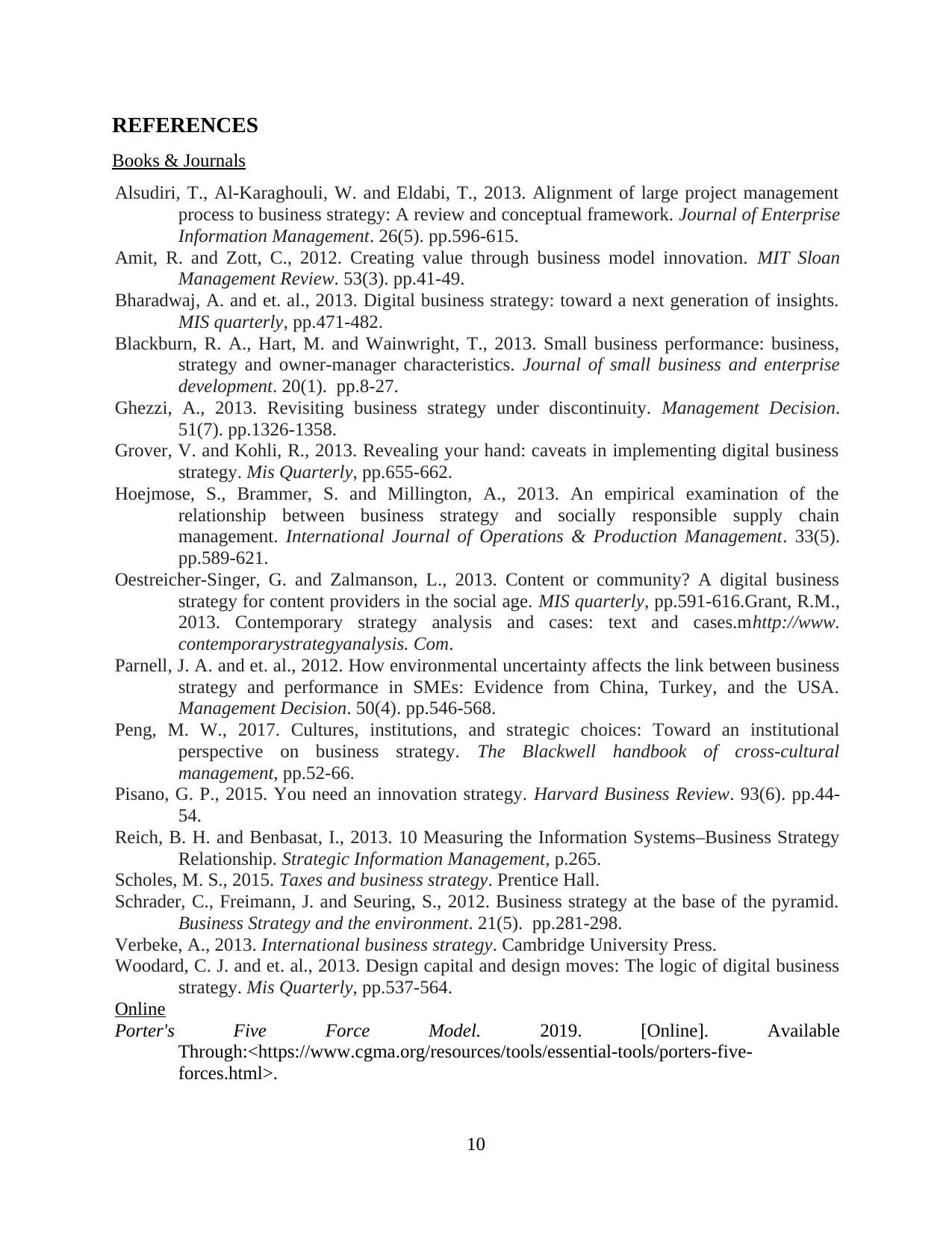
REFERENCES
Books & Journals
Alsudiri, T., Al-Karaghouli, W. and Eldabi, T., 2013. Alignment of large project management
process to business strategy: A review and conceptual framework. Journal of Enterprise
Information Management. 26(5). pp.596-615.
Amit, R. and Zott, C., 2012. Creating value through business model innovation. MIT Sloan
Management Review. 53(3). pp.41-49.
Bharadwaj, A. and et. al., 2013. Digital business strategy: toward a next generation of insights.
MIS quarterly, pp.471-482.
Blackburn, R. A., Hart, M. and Wainwright, T., 2013. Small business performance: business,
strategy and owner-manager characteristics. Journal of small business and enterprise
development. 20(1). pp.8-27.
Ghezzi, A., 2013. Revisiting business strategy under discontinuity. Management Decision.
51(7). pp.1326-1358.
Grover, V. and Kohli, R., 2013. Revealing your hand: caveats in implementing digital business
strategy. Mis Quarterly, pp.655-662.
Hoejmose, S., Brammer, S. and Millington, A., 2013. An empirical examination of the
relationship between business strategy and socially responsible supply chain
management. International Journal of Operations & Production Management. 33(5).
pp.589-621.
Oestreicher-Singer, G. and Zalmanson, L., 2013. Content or community? A digital business
strategy for content providers in the social age. MIS quarterly, pp.591-616.Grant, R.M.,
2013. Contemporary strategy analysis and cases: text and cases.mhttp://www.
contemporarystrategyanalysis. Com.
Parnell, J. A. and et. al., 2012. How environmental uncertainty affects the link between business
strategy and performance in SMEs: Evidence from China, Turkey, and the USA.
Management Decision. 50(4). pp.546-568.
Peng, M. W., 2017. Cultures, institutions, and strategic choices: Toward an institutional
perspective on business strategy. The Blackwell handbook of cross‐cultural
management, pp.52-66.
Pisano, G. P., 2015. You need an innovation strategy. Harvard Business Review. 93(6). pp.44-
54.
Reich, B. H. and Benbasat, I., 2013. 10 Measuring the Information Systems–Business Strategy
Relationship. Strategic Information Management, p.265.
Scholes, M. S., 2015. Taxes and business strategy. Prentice Hall.
Schrader, C., Freimann, J. and Seuring, S., 2012. Business strategy at the base of the pyramid.
Business Strategy and the environment. 21(5). pp.281-298.
Verbeke, A., 2013. International business strategy. Cambridge University Press.
Woodard, C. J. and et. al., 2013. Design capital and design moves: The logic of digital business
strategy. Mis Quarterly, pp.537-564.
Online
Porter's Five Force Model. 2019. [Online]. Available
Through:<https://www.cgma.org/resources/tools/essential-tools/porters-five-
forces.html>.
10
Books & Journals
Alsudiri, T., Al-Karaghouli, W. and Eldabi, T., 2013. Alignment of large project management
process to business strategy: A review and conceptual framework. Journal of Enterprise
Information Management. 26(5). pp.596-615.
Amit, R. and Zott, C., 2012. Creating value through business model innovation. MIT Sloan
Management Review. 53(3). pp.41-49.
Bharadwaj, A. and et. al., 2013. Digital business strategy: toward a next generation of insights.
MIS quarterly, pp.471-482.
Blackburn, R. A., Hart, M. and Wainwright, T., 2013. Small business performance: business,
strategy and owner-manager characteristics. Journal of small business and enterprise
development. 20(1). pp.8-27.
Ghezzi, A., 2013. Revisiting business strategy under discontinuity. Management Decision.
51(7). pp.1326-1358.
Grover, V. and Kohli, R., 2013. Revealing your hand: caveats in implementing digital business
strategy. Mis Quarterly, pp.655-662.
Hoejmose, S., Brammer, S. and Millington, A., 2013. An empirical examination of the
relationship between business strategy and socially responsible supply chain
management. International Journal of Operations & Production Management. 33(5).
pp.589-621.
Oestreicher-Singer, G. and Zalmanson, L., 2013. Content or community? A digital business
strategy for content providers in the social age. MIS quarterly, pp.591-616.Grant, R.M.,
2013. Contemporary strategy analysis and cases: text and cases.mhttp://www.
contemporarystrategyanalysis. Com.
Parnell, J. A. and et. al., 2012. How environmental uncertainty affects the link between business
strategy and performance in SMEs: Evidence from China, Turkey, and the USA.
Management Decision. 50(4). pp.546-568.
Peng, M. W., 2017. Cultures, institutions, and strategic choices: Toward an institutional
perspective on business strategy. The Blackwell handbook of cross‐cultural
management, pp.52-66.
Pisano, G. P., 2015. You need an innovation strategy. Harvard Business Review. 93(6). pp.44-
54.
Reich, B. H. and Benbasat, I., 2013. 10 Measuring the Information Systems–Business Strategy
Relationship. Strategic Information Management, p.265.
Scholes, M. S., 2015. Taxes and business strategy. Prentice Hall.
Schrader, C., Freimann, J. and Seuring, S., 2012. Business strategy at the base of the pyramid.
Business Strategy and the environment. 21(5). pp.281-298.
Verbeke, A., 2013. International business strategy. Cambridge University Press.
Woodard, C. J. and et. al., 2013. Design capital and design moves: The logic of digital business
strategy. Mis Quarterly, pp.537-564.
Online
Porter's Five Force Model. 2019. [Online]. Available
Through:<https://www.cgma.org/resources/tools/essential-tools/porters-five-
forces.html>.
10
⊘ This is a preview!⊘
Do you want full access?
Subscribe today to unlock all pages.

Trusted by 1+ million students worldwide
1 out of 13
Related Documents
Your All-in-One AI-Powered Toolkit for Academic Success.
+13062052269
info@desklib.com
Available 24*7 on WhatsApp / Email
![[object Object]](/_next/static/media/star-bottom.7253800d.svg)
Unlock your academic potential
Copyright © 2020–2025 A2Z Services. All Rights Reserved. Developed and managed by ZUCOL.



